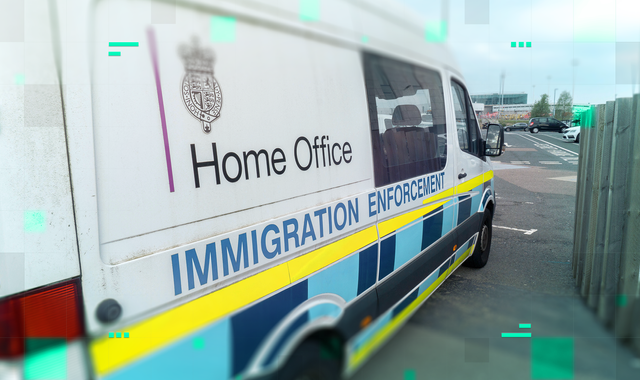
Based on the 1951 Convention on Refugees, anyone who has a well-founded fear of persecution can claim asylum in the UK, be that based on their race, religion, nationality, sexuality or other reason. They must be in the UK to do so.
A record 111,084 people claimed asylum in the UK in the latest year to June 2025, the highest number in figures collected since 2002. Around two in five - 41,870 - of those were made by people who arrived in small boats.
The increase in claims has mostly been driven by people seeking asylum from countries in South Asia, the Middle East, and sub-Saharan Africa.
The number of claims was relatively low between 2006 and 2021, before increasing rapidly in recent years.
Over the whole period from 2002 to 2025, the top five nationalities of those claiming asylum were Iran, Afghanistan, Pakistan, Iraq and Eritrea. Asylum claims from Middle Eastern countries were highest between 2022 and 2023, while asylum claims from Eritreans and Pakistanis have continued to increase in recent years.
The most common nationalities of those seeking asylum are often those from countries experiencing war and violent persecution, seen, for example, in the surge in refugees coming from Afghanistan following the Taliban's takeover in 2021.
Increasing numbers of asylum seekers have arrived in the UK by irregular routes, mostly on small boats across the English Channel - with Afghans and Eritreans making up the largest proportion of small boat arrivals in the last year.
In the latest year to June 2025, the greatest number of asylum claims were from people from Pakistan, at 11,234, followed by Afghanistan at 8,281, Iran at 7,746, and Eritrea at 7,433.
The majority of asylum claims come from younger men aged under 50, who represented 59% of asylum seekers in the latest figures, followed by children, at 22%.
There were 19,471 children among people claiming asylum, more than double from 7,672 a decade earlier, while the number of men under 30 quadrupled to 41,553 over the same period.
Prime Minister Sir Keir Starmer says he wants to 'smash the gangs' and disrupt the networks of organised criminals who make small boat journeys possible.
But as with the Conservative government that came before him, he has not been successful. The number of small boat crossings so far this year, at just under 29,000, is higher than by the same point in any previous year.
But while half of asylum seekers arrived irregularly by small boat or without documentation, the rest arrive by more conventional routes.
At 41,100, an almost identical number of people claimed asylum who initially arrived on a work, study, or other valid visa as the 41,870 who arrived 'irregularly'.
Another government promise on immigration is increasing the number of deportations and removals of people who have no legal status in the UK, which they also say will act as a deterrent to others.
This includes the 'one-in-one-out' scheme recently agreed with France, under which, on a trial basis, a small number of people who arrive in small boats are returned to France in exchange for asylum seekers on safe and legal routes. The government say that 100 people have been detained in preparation to be sent to France.
Who gets asylum in the UK?
In the year to June 2025, 51,997 people were given a grant of protection or other leave, 39% of 134,037 initial asylum decisions made.
This is compared to the higher figure of 57,905 who were refused asylum, 43% of the total. The rest either withdrew their claim or it was closed for other administrative reasons.
Nigel Farage's Reform UK say that if it is elected, it plans to deport everyone who has arrived irregularly in the UK, such as by crossing the channel in a small boat or concealed in a lorry.
However, asylum claims from those who arrived in small boats are more likely to be approved compared with those made by people who overstayed their visa.
At 53%, more than half of the asylum claims by people who arrived in small boats were granted in the latest year, of those where an initial decision has been made, greater than the 39% grant rate overall for all asylum applications.
This is based on initial decisions - though some of those whose asylum has been rejected may go on to appeal the decision.
The government has not recently published figures on asylum appeals, but based on historic figures, around half of appeals are successful.
The country with the most refused asylum claims in the latest year was Pakistan, at 6,313, closely followed by Afghanistan, at 6,066, Bangladesh at 4,614 and Iran at 4,223.
Rejected asylum seekers are currently unlikely to be deported, based on current returns figures. Doing so would require an agreement with the countries involved, says Dr Peter Walsh, a senior researcher at the Migration Observatory, a research institute at the University of Oxford.
"This is a challenge that's been getting more difficult in recent years, and it's largely due to [rejected asylum seekers] countries of origin. If you have an Afghan asylum claimant who's been refused, we don't currently have relationships with the Taliban or any kind of returns agreements," he said.
Germany recently returned a small number of Iranian nationals to Iran, deporting 14 people there in 2024 and a further 11 in the first half of 2025.
"It's not impossible, but certainly there would be a lot of diplomatic work that would have to be carried out to secure that kind of returns deal. Iran is currently under sanction. You can imagine the diplomatic challenges in trying to secure a returns agreement with the Iranian regime."
"And, you have to imagine that actually quite a decent share of individuals who have left those countries would be at risk of persecution," he added.
Who is deported from the UK?
The government has been successful in its aim to increase the number of returns and deportations from the UK.
In the latest year to June 2025, there were 35,833 people returned. Most of those people were either voluntarily or forcibly returned to their home country.
This is greater than the 30,939 returned in the year before, and the highest it's been since 2016, though below a peak of over 47,000 returns in the year to June 2012.
Around one in six of the people returned were foreign national offenders. However, with limited detail in the figures, it is not possible to say exactly what proportion of the rest of the people returned were failed asylum seekers or not.
Three-quarters of those returned left voluntarily, while the remaining 9,072 were forcibly removed. Almost all of them were sent from detention centres, which may include foreign national offenders, or people who never made an asylum claim and were detained by immigration enforcement.
More than two-thirds of the 35,833 returns in the latest year were to seven countries: India, Brazil, Albania, Romania, China, Nigeria, and Pakistan.
"Labour is deciding more asylum cases, and success rates are in line with EU neighbours," Professor Nando Sigona of the University of Birmingham told Sky News.
"It is difficult to remove people to countries with political unrest and human rights crises. Removals are increasing, but mostly towards countries with which we have better diplomatic relations. Most of those removed are not the irregular crossers but visa overstayers."
The Data and Forensics team is a multi-skilled unit dedicated to providing transparent journalism from Sky News. We gather, analyse and visualise data to tell data-driven stories. We combine traditional reporting skills with advanced analysis of satellite images, social media and other open source information. Through multimedia storytelling we aim to better explain the world while also showing how our journalism is done.

(c) Sky News 2025: Where are the UK's asylum seekers from?


 Gaza hospital rejects Israel's claim troops 'saw Hamas camera' before deadly attack
Gaza hospital rejects Israel's claim troops 'saw Hamas camera' before deadly attack
 Israeli protesters demand Netanyahu does whatever it takes to bring hostages home - but is he listening?
Israeli protesters demand Netanyahu does whatever it takes to bring hostages home - but is he listening?
 Farage's small boats plan not about policy but putting Labour and Tories on the spot
Farage's small boats plan not about policy but putting Labour and Tories on the spot
 Three victims of Isle of Wight helicopter crash named
Three victims of Isle of Wight helicopter crash named
 Sex offender murdered in 'brutal and sustained' attack after recent release from prison
Sex offender murdered in 'brutal and sustained' attack after recent release from prison
 Taylor Swift announces engagement to boyfriend Travis Kelce
Taylor Swift announces engagement to boyfriend Travis Kelce
 Six injured after Leicestershire dog attacks
Six injured after Leicestershire dog attacks
 Epping migrant hotel resident told girl, 14, he wanted her to have his baby, court hears
Epping migrant hotel resident told girl, 14, he wanted her to have his baby, court hears




